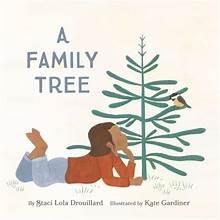Ojibwemowin language
2 Reviews
(2)
K-3
Illustrated by
Gardiner Kate.
When Francis's family plants Gaawaandagoonce ("little spruce" in Ojibwemowin) in her grandmother's garden located alongside Gichigamiing (Lake Superior), the tree and baby Francis are almost the same height. The two grow together: "While Francis learned to walk on two little feet, the spruce tree walked in her own way -- stretching her roots out into the ground, where they talked to roots of other trees." Grandma knows that "trees, like people, are stronger together," which is why Gaawaandagoonce was planted near older spruces. Drouillard's inviting text naturally weaves information about trees' root systems and species' interconnectedness into a story about adjusting to change. When Francis's grandparents eventually need to move from their Grand Portage home, the family brings the little spruce to Francis's aunt's house. They carefully and lovingly transplant the tree, but acclimating is tough. Slowly, she connects with the other spruces and begins to feel at home again. Children who have had to move to a new place will relate to Francis and Little Spruce. The gouache and colored-pencil drawings' limited palette is a good match for the text's contemplative tone. An author's note explains that the story is based on a real spruce tree, and Drouillard discusses the importance of land and the significance of its loss for the Ojibwe people. Two Anishinaabe uses for white spruce and a glossary of the Ojibwemowin words included in the story are also appended.
Reviewer: Nicholl Denice Montgomery
| Horn Book Magazine Issue:
July, 2024
(2)
PS
Illustrated by
Jennifer Faria.
This sweetly unassuming picture book is simultaneously a small wintertime adventure, a story of a loving intergenerational friendship, and an animal-identification book incorporating both English and Ojibwemowin vocabulary. On a snowy day, a very young boy and his grandfather take a walk in the woods across from their home. On their walk, they encounter a black bird. Grandpa introduces the bird first in English as "Raven" and then in Ojibwemowin as "Gaagaagi." The pattern is repeated with "Rabbit" ("Waabooz") and "Deer" ("Waawaashkeshi"). As they walk, the boy and Grandpa make tracks in the snow, comparing them with the animal tracks they see. Their encounters with the woods' wildlife are interspersed with moments demonstrating the warm relationship between the two. At book's end, they head home for milk and cookies and a nap. Acrylic and colored-pencil illustrations vividly portray the snowy landscape as well as the boy and grandfather's home; the bright yellow living room filled with mementos radiates love and warmth. Endpapers helpfully label the three animals with their English and Ojibwemowin names; the Ojibwemowin names are also spelled phonetically.
Reviewer: Nicholl Denice Montgomery
| Horn Book Magazine Issue:
January, 2021
2 reviews
We are currently offering this content for free. Sign up now to activate your personal profile, where you can save articles for future viewing.





